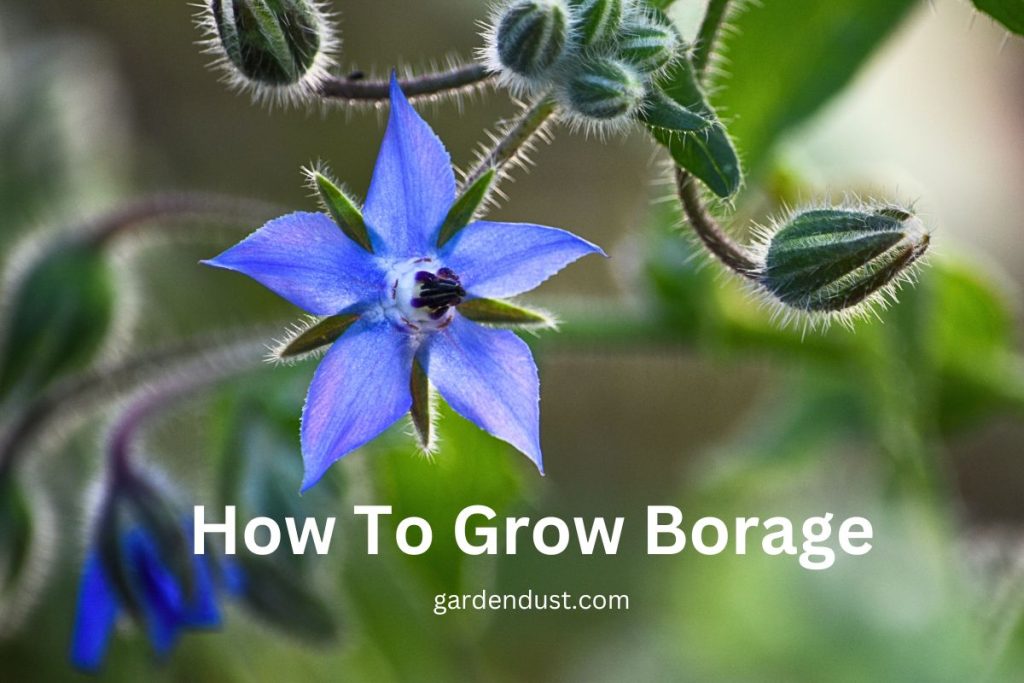Borage (Borago officinalis), often referred to as the “starflower,” is a delightful and versatile herb that not only adds visual appeal to your garden with its vibrant blue flowers but also serves practical culinary and medicinal purposes. Known for its resilience and ease of cultivation, borage is an excellent choice for both novice and experienced gardeners. In this comprehensive guide, we will explore how to grow borage the step-by-step process of growing borage and provide insights into its care, maintenance, and various uses. Let’s begin…
Botanical Name: Borago officinalis
Native: Mediterranean region
Common Name: Borage
Family: Boraginaceae
Genus: Borago
Flower Colour: Blue, occasionally pink or white
Flower – vibrant star-shaped
Blooming Time: Late spring to early fall
Plant Type: Annual herb, branching stems covered in bristly hairs
Height-1 to 3 feet
Leaves -large, rough, and oval-shaped, with a distinctive wrinkled texture
Grow And Care For Borage-
Selecting the Right Location:
Borage is a sun-loving plant that thrives in well-drained soil. When choosing a location for planting, opt for an area that receives full sunlight. Borage is adaptable to various soil types but prefers moderately fertile, well-draining soil.
Sowing Borage Seeds:
Timing: Borage seeds can be sown directly in the garden in the spring or fall.
Spacing: Sow seeds about 18 to 24 inches apart to allow ample space for the mature plants.
Depth: Plant the seeds at a depth of approximately 1/4 to 1/2 inch in the soil.
Germination: Borage seeds germinate relatively quickly, usually within 7 to 14 days.
Watering and Soil Care:
Establishment: Keep the soil consistently moist during the germination and establishment phase. Once the plants are established, borage is drought-tolerant.
Watering Frequency: Water borage occasionally, providing deep watering when needed rather than frequent shallow watering.
Maintenance Tips:
Deadheading: Regular deadheading helps promote continuous blooming and prevents the plant from becoming too leggy.
Staking: Borage plants can grow tall, and their stems may need support to prevent them from flopping over. Consider staking if necessary.
Pruning: Prune borage periodically to encourage bushier growth. Cut back the stems during the growing season to maintain a more compact form.
Fertilizing Borage:
Borage is not demanding when it comes to fertilization. A moderate application of balanced fertilizer in the spring is usually sufficient for healthy growth. Avoid over-fertilizing, as this can lead to excessive foliage at the expense of flowers.
Harvesting Borage:
Leaves: Harvest borage leaves when they are young and tender. They have a mild cucumber flavor and can be used in salads, drinks, or as a garnish.
Flowers: Harvest the flowers when they are fully open for the best flavor. Borage flowers are not only edible but also make attractive decorations for various dishes.
READ ALSO:-How To Grow And Care For Dill Plant
Overwintering:
Overwintering: While borage is an annual, it may self-seed and return in the following growing season. Allow some plants to go to seed if you desire a natural reseeding effect.
Pests and Diseases:
Borage is relatively resistant to pests and diseases. The plant’s attractive flowers may attract bees, which could be a consideration for individuals allergic to bee stings. Understanding these key elements will help you successfully grow, appreciate, and utilize the diverse qualities of borage in your garden and kitchen
Usages
Culinary Uses:
Borage leaves and flowers are edible. Leaves have a mild cucumber flavor and are used in salads, soups, and drinks. Flowers are often used as a garnish and are sometimes candied for decorative purposes.
Medicinal Uses:
Borage has been traditionally used for its medicinal properties. The leaves are used in herbal teas and tonics. It is believed to have anti-inflammatory properties.
Wildlife Attraction:
The attractive blue flowers of borage are known to attract pollinators, especially bees, making it a beneficial plant for supporting biodiversity in the garden.
Companion Planting:
Borage is often used as a companion plant for tomatoes and strawberries, enhancing their flavor and repelling certain pests.
Propagation
Borage (Borago officinalis) can be propagated through seeds and, to some extent, by self-seeding. Here’s a brief guide on propagating borage:
1. Propagation from Seeds:
- Seed Collection: Allow some of the borage flowers to mature and produce seeds. The seeds are small and black.
- Sowing Time: Borage seeds can be sown directly in the garden in the spring or fall. Choose a sunny location with well-draining soil.
- Planting Depth: Sow the seeds at a depth of approximately 1/4 to 1/2 inch in the soil.
- Germination: Borage seeds typically germinate within 7 to 14 days.
- Seedlings: Once the seedlings have grown large enough, they can be transplanted to their final growing locations if needed.
2. Self-Seeding:
Borage is known for self-seeding prolifically. Allow some plants to go to seed, and they will often produce new plants in the surrounding area. If you want to control the spread of borage, consider deadheading flowers before they go to seed.
Propagation Tips:
- Borage is an annual, but due to its self-seeding nature, it often returns in subsequent growing seasons.
- Be prepared for volunteer seedlings to emerge in different areas of your garden where seeds have fallen.
- Borage has a taproot, so transplanting mature plants can be challenging. It’s generally more successful to sow seeds directly in the desired location.
Growing borage is a rewarding experience that brings both beauty and utility to your garden. By following these detailed steps and tips, you can cultivate healthy borage plants and enjoy the multifaceted benefits this resilient herb has to offer. Whether you’re enhancing your culinary creations or exploring traditional herbal remedies, borage is a valuable addition to any garden. Happy Gardening…






